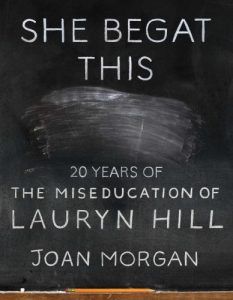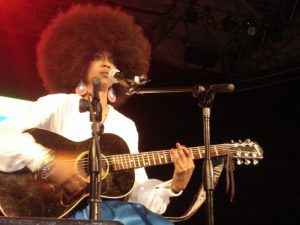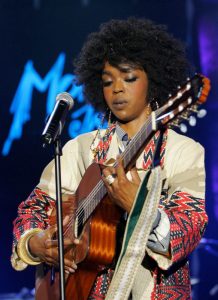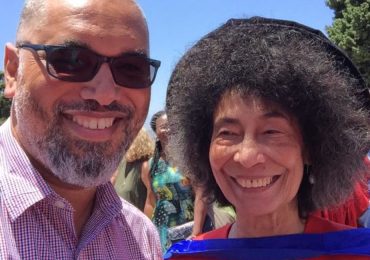As Bongani Madondo experienced tinges of nostalgia occasioned by the twentieth anniversary of The Miseducation of Lauryn Hill, HipHop Feminist Joan Morgan dropped She Begat This, a heartfelt gem of book that, like the album and its auteur, sings to its own beat.
 She Begat This: 20 Years of The Miseducation of Lauryn Hill
She Begat This: 20 Years of The Miseducation of Lauryn Hill
Joan Morgan
Simon and Schuster, 2018
1. Intro
i. White people had Judy Garland. We had Nina.
—Richard Pryor
ii. Lauryn Hill was not just famous but like, white famous.
—Joan Morgan
iii. No Lauryn, you aren’t Nina Simone. And even Nina was not three hours late for a concert.
—Karen Good Marable
iv. We told Lauryn she was royalty and crowned her the next Nina Simone. And right after that we summarily stripped away her humanity by demanding she do more.
—Joan Morgan

2. Spring of 1996
The first-ever moment I laid my peepers on Lauryn Hill, the experience felt as though chemically-induced. It was not love at first sight. It was a ‘surrender your ass to the goddess’ kind of love. A chocolate-dipped, fierce, beautifying kind of African godly love: totally visual, for one. An inexplicable and visceral kind of love. The sort of love I swear throngs of millennials (should) have experienced at their first sighting of TED-talking Chimamanda Ngozi Adichie, post-Half of a Yellow Sun, warning us about the dangers of a single story. A yellow-sun kind of love.
*
THE JOINT was palpable with a Negritude-redux air, unlike any I’d experienced before. Instead of nineteen-sixties dashikis and huge-ass Afros or berets, black leather and all that Black Panther’esque leitmotif recently ripped off by Beyoncé and intersectional woke-ists, this was a singular affair. The Brixton Academy in South London, home-away-from-home for the Windrush populace and their descendants in ‘Inglan’, played host to a heady Afropolitan and rock séance. Long before Afropolitanism became cannibalised by cash-till-fixated charlatans and their attendant media. The ambience vibed something like, to pilfer Don Letts’s album title: Dread Meets Punk Rockers Uptown.
Brimful of ruggedly handsome Hotepian br’d’rn in the requisite yellow, green, red and black binis, hardly covering their Lion of Judas manes, and the obligatory white girls with midnight-black kohl over their eyelashes, super-tight leather mini-skirts over black stockinged legs, some wrapped in Ethiopian scarfs, tresses down to their lower backs. Neck jewellery chain-flouncing B-boys in prison-style denim pants ten times their waist size and riding below their crotches and their Nubian-weaved boos were in the house, too.
There was also the jazz-lovin’ mid-forties crowd. The sort that had Ronny Jordan and Courtney Pine on needle-repeat back home and could debate you about CLR James, Derek Walcott and Stuart Hall; stick around and you were likely to hear them go, Hey broddah dat bamba-klat VS Naipaul ihm tink he white mohn. Me ses: poorest white mohn here know ihm nah white, mohn.
Eyes trained on the stage, I espied the girl.
She was about eighteen or nineteen and had short, thick, tightly rolled locks. Chocolate brown skin and a structure petite and fit as an athlete’s. She was not alone. The girl was with her brothers. Don’t fuck with her: she’s got two patois-spitting brothers right beside. They are not her ‘brothers’ literally. They are family in the Civil Rights kind of community-making manner. Turns out, one of the pair is her high school chum and the other her lover on the down-low. And he is Haitian. Not quite a yardie. My immigrant pals in Brick City (Brooklyn) once put me on red alert: ‘Yo, Shaka Zulu, listen here. Dem “rude bwoys” are lethal, alright. But Haitians, m’fckers? Double trouble.’
‘Those Africans from Port-au-Prince are the only Africans, not discounting the Ethiopians and you Zulus, to kick European superpower nations’ asses in wars.’
Rumour circulating then was that one of them, Prakazrel Michél, was first cousin to the other bandmate—that one with the thick African accent they called ‘Wee-Clef’. Even as early as then, Wyclef Jean came across as a Haitian intellectual gangster who prided himself for being ‘son of a preacher-man’. Whispers were that he was married to a Haitian; he had his claws deep in the chocolate queen with the locks and the sing-songy coarse voice.
Oh, wait.
Right then, she strutted from behind stage already singing and rapping over a Roberta Flack classic, ‘Killing Me Softly’. Brixton Academy, 1996. My nineteen-nineties London sojourn was owed to a bundle of excuses, including attempts to score a gig with Caribbean news-rags and a foolish yooth’s ambition to hang out with Socialist Workers Party types. Oh well, blame that on an overdose of New Left Review magazines while loafing in Hillbrow, a village boy turned beatnik hobo under Johannesburg’s mesmerising Milky Way.
But also I was in London on a deeply personal, if not, now—with the benefit of age—entirely knuckle-brained mission: to meet the Asian left-wing intellectual whose black consciousness, far-leftism and punk swagger chimed with my nascent construction of black and global, black and punk, black and totally pan-Asian culture. I was a transfixed local boy with tic-toc, tic-toc global cultural antennae. Back then, Tariq Ali was God or Marx or Garvey’s singular gift to the black and brown intellectual movement the world over, just that the world had not realised it then, I felt.

3. Delivered—to Wall Street
Brixton Academy is hot with the sort of international black love and fuck-you multiracialism I’ve been dreaming of. It’s a major night, not only in the borough, the city and the region, but in the entire ‘Inglan’. The biggest-selling American HipHop band, The Fugees, part intellectual merry-prankster revué touring Babylon by bus, part African travelling vaudeville troupe, holds forth, and the congregants are giving the band reciprocal dollops of love.
The Haitian son of a preacher man is busy humping an electric guitar, not like Jimi Hendrix, much more X-rated. When not tonguing it he is threatening to pour gasoline on it and burn the house down. The cousin is prancing around clutching his crotch, as per misogym-nastic HipHop poseur obligation. You too start believing if he stops clutching it like that, dem balls will bounce out of their skin-sack and roll down the stage. Clutch ’em, homeboy, you chant in your head.
The Fugees invite a guest on stage. The guest goes by the name of Nas Escobar. No, he is not Columbian. HipHop is the one musical culture, more theatrically self-aware than the jazz or rock scene, that has always had an acute understanding of a specific expression of fiction: fantasy and ghetto, the visual burlesque. The whole affair renders it both achingly authentic and comic by turns. Only in this culture can band leaders and solo acts wear criminal characters ripped straight from pulp ghetto noirs and B-movie thugs and come out loveable: Scarface, Escobar, Bambino, Gotti Jnr, Corleone—it doesn’t matter these boys from American projects and suburbs have never set foot in Sicily or Medellin.
Mr Nas Escobar shuffles onto the stage, emits poetic rhymes and bars. Slim, but shapely with long legs, the girl hops over and gets three inches off Mr Escobar’s face and starts singing in a buttery soul voice. A blue hymnal shrouded in Caribbean patois, and driven by an actual band, late Bob Marley’s mates, The Wailers, playing dub ska-meets King Tubby futuristic bass, while the girl‘s voice climbs the notes. The song conjures up imaginary mountains and imagery of the Serengeti and postcard visual shorthand palaces filled with gold and African masks.
Her voice, mellifluous, narrates a grab bag of neo-Afrocentric mini-novellas about fantastic African Queens, Cleopatra[s], Isis goddess and rasta-Kushite folklore. She’s spouting the sort of necessary diasporic fantasies black Israelites everywhere, from nineteen-seventies Harlem 125th Street to Brixton’s Cold Harbour Lane and back, have had on lockdown. Gliding off her tongue, the vocal lecture, a remix of Yosef Ben-Jochannan, John Henrik Clarke via Audre Lorde and African tourism brochure fare, rouses us to seek, indeed claim the sort of Afrotopia we’ve long been denied, anywhere we are, even if we claim it right in Queen Lizzy’s ‘Inglan’.
The lesson itself stings like a bee and soothes just as beautifully. Preach, Mama, preach! We are entranced but come up for air to catch her lyrics, now clear as raindrops:
If I r-o-o-o-ld the world, imagine that / I’d free all my sons, I love ’em love ’em baby / Black diamonds and pearls
*
Boy o’ boy. You could have brushed me with the lightest feather and I would have keeled over and died right then. Something in me felt resuscitated that night: perhaps it was that true HipHop would deliver us from the twin monsters of racism and the capitalist pop machine. Little did we know we’d be plunged into the same existential crisis that has plagued the most well-meaning among us since Adam and Eve developed sympathy for the devil: selling out.
While outfits such as The Fugees, A Tribe Called Quest, Jungle Brothers, Guru, Queen Latifah and The Roots, among others, stood atop the Mount Rushmores of this world, dropping science on African self-reliance a good twenty years before cinematic Wakanda became the thing, HipHop had stopped being For Us By Us. The nineteen-nineties will go down in history as the decade in which chickenheads not only came home to roost, but when the culture finally delivered black anxieties and ingenuity, complete with F-bombs and crotch grabbin’ poses, bleeps and Parental Advisory stickers optional, to Wall Street.

4. Our Lauryn
That night, the girl ceased to be a girl in my heart. Unbeknownst to me at the time, Lauryn Hill, or the idea of her, would become a constant in my life, two years after I saw her and her merry band of Negritude brothers, fly dandies and punk as fuck. While mid-nineteen-nineties London was a disaster of a learning curve for me, Lauryn Hill’s voice and beauty remained an abiding memory through which I was able to glimpse how black love (and ultimately human love), African beauty and live ritual might have been, and may be, centuries yonder.
What I also took away from the Fugees concert is that there is no single black experience, that we are united through our diversity and singularities. It also became manifest two years later, when Hill dropped the seminal album The Miseducation of Lauryn Hill at the age of twenty-three, that there is no single Lauryn Hill. That Lauryn Hill is us and herself. That Lauryn Hill is not Lauryn Hill but the canvas on which black folks, specifically black women in their phenotypical variations—natural, chicory brown, mixed ancestry, peach-yellow—sought alternative modes of expression. Even at that tender age Lauryn Hill and the idea[l] of Lauryn Hill served as the pathway out; the tao through which women of all stripes, black, continental African, Latina, Asiatic, economically hard-done-by, aspirational and so on, pertinently and necessarily projected their desires and dreams, and took their sustenance from.
In a sense, thus, Lauryn Hill was the ultimate global pop star for her and subsequent generations. Her story is the stuff of transformative art channeled from the belly up via the heart’s arteries. We held her aloft: Our lodestar. Our friend. Our lover. Our mother—and with that the ever-attentive layers denoting an erotic-spiritual warrior witch.
Our! Our! Our!
In her we created a near-perfect symbol of patience and fire: she was fierce, accommodative and taking no bullshit. Never mind that she was deeply hurting right in front of us. Why care? She bore the mantle of a heroine without whom we felt we could not navigate a world in which the odds were stacked against ‘we children who are darker than blue’. Nah, she didn’t ask for it. And yet, in some cruel irony, she did. Why did she dare create that sort of music? Why did she dare to be so beautiful? So smart? Hey Lauryn, you sexy thing, come uplift us! We stitched and hung on her soul and image all sorts of African, humanist and womanist dreams, national, global and deeply personal struggles too weighty on us, without even caring how human, or how young she was. We also told her she was Nina Simone. We told her she is our Joan of Arc. Our Mahalia. Our Zora. Our Winnie. Our Miriam. Our Audre Lorde. Our Coretta. Our Rita Marley. ‘Retha Franklin, too. Our Saint John Lennon, imagine that.
But without fail we always returned to Nina, in the very decade Nina had all but been erased from history. ‘We told her she was fucking Nina Simone, and she had only one album!’ the writer and activist dream hampton, who is expressly critical of the album, laments in ‘the godmother of HipHop Journalism’ Joan Morgan’s new and heartfelt gem, She Begat This: 20 Years of The Miseducation of Lauryn Hill.
5. So here I am, Boo, lovin’ you
Joan Morgan, a first-generation daughter of Jamaican immigrants from the South Bronx, New York City, first came into prominence while writing for publications such as Vibe, The Village Voice, MS, Spin and later as an executive editor at Essence magazine in the early nineties to mid-two-thousands. Reflective of the culture itself, HipHop Journalism was a boy’s terrain. In its pages and radio shows, journalistic B-boys and boho brothers puffed out their editorial chests and displayed plumage to each other in the form of whose scoops and interviews were longer, bigger and better than the others.
It was a big corporate media battle frontier, where testosterone coursed through Gonzoid talents in gladiatorial-editorial circles fraught with all sorts of line-blurring between the newsroom and the street. Writers’ and photographers’ balls were constantly weighed against, for, in complement with and in contrast to rap music’s own reigning street kings and their entourages, their necks stacked with gold and African medallions. Black patriarchy, Western patriarchy, capitalism’s patriarchies coalesced to erase the black woman, while the culture took pride in screwing her and had her butt naked selling its videos—mini ghetto superstar flicks. This was the working culture Joan Morgan and a slew of other women, such as dream hampton, Akiba Solomon, Karen Good Marable, Rachel Cepeda, the late Erica Kennedy, Kierna Mayo—who contributed an impassioned yet hilarious and affirmative foreword to Morgan’s book—and many others, came up through.
Morgan was not interested in breaking through the ceiling but rewiring the entire game: both HipHop culture and the media attendant on and derivative of. While her Village Voice coverage of Mike Tyson’s rape trial in 1991 earned her accolades, including the Excellence Award from the National Women’s Political Caucus, it was through her book When Chickenheads Come Home to Roost that Morgan helped re-engineer a new language, discourse and frame through which blackness, activism and HipHop—as well as misogyny and capital power—within and without the culture would be seen and engaged with. Though broader in scope, as might be expected of a literary work, than packaged CD lyrics, Chickenheads was, from the get-go, in conversation with all of Lauryn Hill’s work, particularly Miseducation, which dropped the year before, and with Hill’s position as the visual symbol and voice of a generation.
Joan Morgan has all the nineteen-nineties receipts, and more. Almost twenty years later, Morgan, who really never left the culture that shaped her, now steps back up to stake her name, spirit and empathetic yet stinging intellect on the ever-fractious and evolving board of HipHop herstory. Growing up reading her magazine screeds as well as her essays in books and journals, it would be foolhardy of me to try and attach a label to Morgan’s writing style, but here follows an attempt at an incomplete description.
Part neo-soul (more Mary J’s ghetto womanism’s affirmative heart bleeding than Left Eye’s house-burning feminism), part Jamaica-via-South Bronx fly-gal wisecracks and part third-wave radical feminism that builds on both Alice Walker and Betty Davis sensibilities, her style is stylish mainly because she hardly tries to render it performative. Her essays are so deep that they feel basic, accessible and yet spirit-rousing, clear and unadorned like rain drops. Although I will be rightfully slayed for comparing a woman’s literary chops to those of men, reading Morgan evokes the same feeling I experience reading The New Yorker writer Hilton Als (also of Caribbean ancestry) and the novelist Caryl Phillips. I can’t put a finger on it, other than to say, if Rachel Kaadzi Ghansah is the literary equivalent of—nay, comrade to—Kendrick Lamar’s Trump-era HipHop blues, in the manner Alice Walker and Amiri Baraka were literary companions to Nina Simone, then Morgan is both the Mary J and Meshell Ndegeocello of literature. A fierce, smart, ghetto intellectual rewriting cultural scholarship and yet totally warm—a girl next door.
This is most audible in She Begat This. Her ideology and the burning conviction with which she writes is indistinct from the writing’s form. Thus her style is her content and vice versa. Like the seasoned pro she is, she packs different aesthetic weapons, though. For example, looking over her trove of previously published works, her December 2009 cover profile of Lauryn Hill, ‘They Call Me Ms Hill’, with its cool, patient, and penetrating questions, is a remarkable departure from her essay, ‘Fly-Girls, Bitches, and Hoes: Notes of a Hip-Hop Feminist’ in the 1995 issue of Social Text. In the former her voice is calm, almost enabling, serving to create space for her subject, ‘Ms Hill’, while in the latter she is super-fly, street, mocking, and struggling to love brothers and ‘the culture I’ve stayed in an abusive relationship with’.
That essay eviscerated and light-bombed said culture, and laid the paving stones that led Morgan and her fellow Feminists to Morgan’s current book. It named names: Dr Dre, Ice Cube, Snoop Dog, Notorious BIG and all us men in HipHop then and beyond for our double-standard bullshit. To HipHop culture, which she refers to as her lover ‘Boo’, she writes:
So here I am, Boo, lovin’ you, myself, my sistas, my brothers, with loyalties that are as fierce as they are divided. One thing I know for certain is that if you really are who I believe you to be, the voice of a nation in pain and insane, then any thinking black woman’s relationship with you is going to be as complicated as her love for black men.
Her ‘sistas’ are not off the hook, either:
Similarly, feminism must confront the ways in which we are complicit in our own oppression. Men’s exploitation of our images and sexuality in HipHop is, in many ways, done with the permission and cooperation of our sisters. We need to be as accountable to each other as we believe ‘race traitors’ [that is, the hundred or so brothers in blackface cooning in a skinhead’s music video] should be to our communities. As a feminist I believe it is too great a responsibility to leave to men.
6. That reciprocal hug
Although part of the genre of cultural snapshot portraiture that bears witness to the making of seminal moments in our existence—a song, album, or film; Daphne Brooks’ Grace (33 1⁄3 on Jeff Buckley’s rock-soul masterpiece), Greil Marcus’s Like a Rolling Stone and Matt Dobkin’s I Never Loved a Man the Way I Love You come to mind—She Begat This sings to its own beat. For one, Morgan has curated a round-the-fire sisterly conversation. It’s her book and her story to tell, and yet she accommodates a variety of voices—not quite anthologised contributors—as conversation participants. Honey magazine’s founding co-editor-in-chief Kierna Mayo introduces the book with both hands spraying hot lead. With tongue in cheek—she calls out patriarchs, Suzy-come-lately millennials and everyone in between—she ruffles feathers, slays egos and educates us all on the foundational generation that was Black Girl Magic and Black Girl Rocks a good two decades before those became chic.
The chapters are introduced with prelude skits from other women, such as the former editor-in-chief of The Source Akiba Solomon, reggae musician Nadine Sutherland, Karen Good Marable and dream hampton, among others. She Begat This does not make a claim or attempt to present a definitive biography of the artist—nor even of the album that inspired it, for that matter. Morgan might not have aimed to perform such a duty, but she decontextualises Lauryn Hill, the person, the artist, the persona, for both fans and foes, historians and the media, and perhaps most urgently for herself. She has been transfixed by both ‘Ms Hill’ and the culture that birthed her for a while, and this book, with her questions to friends and industry players, and sometimes her doubling-up to answer questions she posed in the beginning, rendering her obviously defensive, must have been a challenging labour of love, indeed.
Love, from one sister to the other: love of two women of different generations shaped by similar and yet variant cultural and family backgrounds. She Begat This, then, is a love letter. Morgan’s also cognisant that love letters can be messy, desperate, beautiful, arousing and always, as this book achieves without trying, pining for that reciprocal hug. Morgan did not write this book for Lauryn Hill and yet she did. How could it be otherwise?
Also, it must be noted: writing books about people who are still alive can be a perilous affair. You want to be as honest as you can while at the back of your mind you are, inevitably, soul-shredded by the voice telling you, What if the subject treats your efforts as ingratiation? I am reminded here of Simphiwe Dana’s reportedly cool reception of Pumla Dineo Gqola’s book, A Renegade Called Simphiwe, which set out to offer us an alternative window through which to appreciate Ms Dana anew, and of course ended up creating one hell of a beautiful mess of a book, apparently shunned by its subject.
The same for Bob Dylan’s most insightful griot, Greil Marcus: the man is arguably the most knowledgeable, committed and radically-left, old-school, Republican-in-temper (unlike the current fascist knuckleheads manning the GOP hate-machine) fan his subject could hope for. And yet the artist is known to have dismissive disdain towards him. Reading She Begat This, I noticed Morgan’s clever power moves, too. The book’s most critical takes on Ms Hill’s ego and art are proffered by the women Morgan has assembled around her.
Filmmaker and journalist with lower-cap name and seriously lofty artistic standards dream hampton, for example, is fiendishly impatient with Ms Hill in both a refreshing and sadly King-making, thus reductive, fashion. That said, she probably ushers forth the best line in the entire book: ‘I don’t want to hear anyone say the word “defecate” anywhere near Nina Simone. Ever.’
7. Outro
At 176 pages, a cool-headed down-memory-lane guide, with digressions into Q&A-style conversations that woulda been jarring were it not for their illuminating fissures—raising issues such as the perils of premature celebrity worship, the double standards women, and, worse, mothers in pop culture are subjected to, among others—the book ultimately entices a jaded lover back home.
Stylistically, as in the format, I also believe it will grow on me. Intellectually, it is a thing of utter beauty. And as a spiritual guide to the import of a contemporary soul classic, She Begat This is unparalleled. Once again, I am in love with—she is no longer a girl, you know.
Mad props, then, to Morgan, the queen dame of HipHop Feminism, a fly-girl, who, as she seeks to remind us of what gifted such anthems as Ex-Factor, Doo Wop (That Thing) and Everything Is Everything their generation-altering powers, does so by wielding her pen pretty much in the orchestral tradition of conducting, with some added funk-you-very-much bounce. What she achieves here is rearranging and orchestrating a classic no one should dare to explain, and she got away with it.
Ayeye!
- Contributing Editor Bongani Madondo is the author/editor of I’m Not Your Weekend Special: Portraits on the Life+Style & Politics of Brenda Fassie and a writer in residence at the Wits Institute for Social and Economic Research (WiSER). He writes on poetry, photography and politics.






Reading this, I said to self, “eh, you know what? This reminds me of something really, really good I read last year — something about the folding of Village Voice.” A quick Google search & how nice to discover it’s the same-same writer. What fantasticly exuberant writing. Distinct, memorable. Now, *She Begat This* is first on the TBR pile.
I wanted my ex lover back and a friend of mine told me to contact robinsonbuckler {{@ hotmail}}. com i did as i was told after i contacted him >>> he told me he will bring my lover back<>he brought him back after 3 days, i am so so so happy